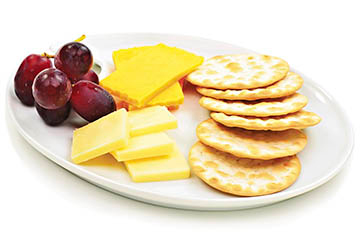By Dale Mayerson and Karen Thompson
Snacks are an important component of the resident nutrition program in long-term care (LTC). They provide increased nutrients and fluids, and are especially important for residents who do not eat full meals in the dining room.
Why snacks?
For residents with small appetites, snacks help to avoid hunger between meals. Many elderly people are easily fatigued and experience early satiety related to delayed gastric emptying. Both of these factors suggest a need for small, more frequent meals allowing residents to take their snacks as they are able. The plan of “6 small meals a day” helps to keep residents well nourished.
Planning snacks
Every resident in LTC should be offered between-meal snacks according to the policies of the home and standards of the province. Snacks are considered part of the meal cycle, which is usually three or four weeks long, and should be planned at the same time as the meals. In this way, snacks complement the meals, optimize variety and avoid repetition. For example, if cheese is served at breakfast, the evening snack should not be a cheese sandwich. Residents Council reviews the menu after it has been developed. If the home has a food committee, the committee is likely involved in helping to plan the menus.as well
The usual snack plan includes a mid-morning drink, a 2 PM snack and a drink, and an 8 PM snack and a drink. Snack menus should include well liked nutrient dense foods and beverages. Items that include protein, vitamins and minerals help residents to maintain their health and weight. Increased meat portions, extra cheese, peanut butter, and yogurt will all increase protein and can be easily added between meals. Other nutritious foods are milk, milkshakes, cookies, muffins, ice cream, puddings, fruit, cheese and crackers, and sandwiches. Eggnogs should not be homemade, since raw eggs must are not considered safe due to risk of salmonella. Commercial eggnogs have been pasteurized and are safe to use.
Seniors lose their ability to recognize thirst so drinks should be offered to residents frequently. For snack times, pitchers of juice, water, milk and/or hot beverages should be offered. Some residents enjoy warm milk or decaffeinated coffee before bedtime. Adequate fluid intake can save residents from increased suffering and staff from increased work. This is especially important during hot weather conditions when residents are at increased risk. Popsicles and freezies should be available and offered frequently in hot weather to keep residents well hydrated.
Foods and drinks served at snack times need to be provided for all diet types and all textures. For example, cookies and sandwiches can both be pureed for residents who require a pureed texture. Recipes are available for all texture-modified foods on the snack menu. Portion sizes are planned and server’s reference current lists outlining specific dietary needs of each resident for all diets and texture modifications. Written procedures will guide staff on how to manage snacks for a resident who is napping or away at the time of snack delivery.
Nutritional supplements may also be served at snack time as ordered according to resident’s individual needs. Residents receiving a nutrition supplement should be offered a snack in addition to their supplement unless otherwise indicated in their plan of care. Staff will report if residents are refusing snacks so that changes can be made according to the resident’s individual needs and wishes.
Serving snacks
Similar to dining, snack time is an opportunity to encourage social interaction. Snacks may be served from a central location or passed from room to room according to the needs of the residents.
Staff provide assistance to those residents who require help in taking their food/fluids and should monitor and document consumption for all residents. Staff records each resident’s intake at snacks just as they do for residents at meal times.
Serving staff must also understand and practice the principles of proper food handling for the snack service. Sandwiches and dairy products should not be left sitting at room temperature for later consumption but should be stored in a refrigerator until the resident is ready for them.
24 hour availability
Food supplies are available for nursing staff to distribute for night emergencies and resident snack requests. A home policy should support the 24 hour availability of food and fluid to ensure that incidents of diabetic hypoglycemia and overnight hunger can be managed. Residents with dementia may wake up during the night and should have access to nutrient rich snacks. A pantry stocked with food items and a kettle, toaster and/or microwave help staff to provide a quick snack to residents at any time of the day or night.
Since LTC homes have a limited food budget, most of the spending for meal planning goes towards the meals, focusing on appetizing protein items and tempting desserts. There is consideration, however, towards improving snack quality to include foods that provide vitamins and minerals that may be lacking in meals, especially for those who don’t eat well or who can’t eat a lot at any given time.
The snack menu cycle is planned for attractive presentation, variety and to enhance the overall fluid and nutrient intake.
Dale Mayerson, BSc, RD, CDE, and Karen Thompson, BA Sc, RD are Registered Dietitians with extensive experience in Long-term care. They are co-authors of “Menu Planning in Long Term Care and Retirement Homes: A Comprehensive Guide” and have participated for many years on the Ontario Long Term Care Action Group, an advocacy group of Dietitians in Canada.


